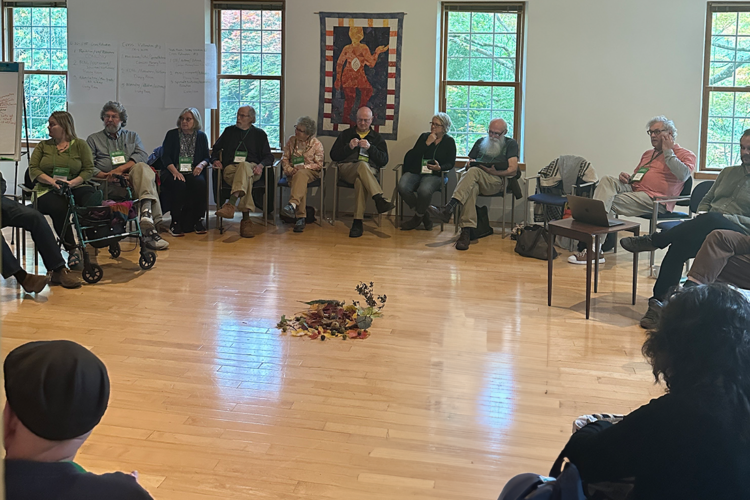Kicking Over the Traces and Restoring Connections

While reading The Unsettling of America: Culture and Agriculture, Daphne Miller, M.D. began underlining more and more passages from a chapter titled, “The Body and the Earth,” riddling its pages with a surfeit of pencil marks and notations (Miller, xii).
With Miller’s medical training and experience as a Professor of Medicine, two sentences particularly caught her attention: “Our bodies are moving particles of the earth, joined inextricably both to the soil and to the bodies of other living creatures. It is hardly surprising, then, that there should be some profound resemblances between our treatment of our bodies and our treatment of the earth” (Berry, 97). Miller felt moved by the author’s perspective and decided to make a pilgrimage to his Kentucky homestead to converse with the poet, storyteller, culture critic, activist, visionary, sixth-generation farmer, and famed author—Wendell Berry.
As a medical professional, Miller wanted to find the connections between farming, medicine, and health, and to incorporate “new paradigms for healing” into her practice (Miller, 2). She arranged to visit a number of innovative farms across the United States to converse with farmers and learn about their holistic practices. Her book Farmacology: What Innovative Family Farming Can Teach Us About Health and Healing, tells the story of her experiences, weaving together these conversations, research by biomedical scientists, and her own observations and insights.
Miller sought out farmers who are trying to make a difference in agriculture, recover agricultural methods from the past, replenish the soil, and live healthy lifestyles in harmony with the Earth. She visited farms like: 1) Jubilee Biodynamic Farm, near Seattle, Washington; 2) Rockin’ H organic, a pesticide-free ranch in the Missouri Ozarks; 3) two contrasting farms, Heartland Egg and Arkansas Egg, both part of the Arkansas egg production industry; 4) Scribe Winery in Sonoma County CA, that utilizes natural, or Integrated Pest Management (IPM); 5) La Familia Verde, an inner city gardening project in Bronx, NY; and, 6) Morning Myst herb farm near Fruitland, Washington, where natural aromatic “hydrosols” for skin health care are produced. Most farms gave Miller new appreciation and awareness of farming practices that fostered wholeness: renewed body-mind connections with earth and spirit; engendered connectivity and reversed isolation; and, favoring natural, earth-oriented health alternatives, loosened ties to the medical industry.
I share Miller’s interest in a healthy organic diet, natural health and healing, and sources of healthy food, so once I started reading Farmacology, it was difficult to set it aside. I’m also a fan of Wendell Berry’s writing. After reading Miller’s Introduction, “Kicking Over the Traces,” I searched for my copy of Berry’s “The Unsettling of America,” to read the chapter which had moved Miller so profoundly. Berry’s powerful prose—deep, insightful, and moving—has plenty of food for thought, whether you are a medical doctor, health advocate, or someone mindful of ecological challenges we face locally and globally.
KICKING OVER THE TRACES
In Farmacology Miller mentions one of Berry’s remarks to her: “You doctors who kicked over the traces interest me a lot” (Miller, xiii). The unfamiliar phrase, “kicked over the traces,” suggests numerous images and notions. In the context of Miller’s “Introduction,” which provides details of her life, “traces” could refer to the subtle impressions one acquires from education and enculturation. The meaning of this expression, however, actually derives from an agricultural context familiar to Berry. The American Heritage Dictionary and The McGraw-Hill Dictionary of American Idioms and Phrasal Verbs cite this 19th-century figure of speech as meaning, to “get rid of restraints,” in reference to the harnesses that attach an animal to a pulled vehicle. So, for example, the horse that kicks its legs over the leather harness straps has gone “out of control,” having cast “authority” aside. The “traces,” all restraints, have been kicked aside. Disencumbered, she’s free to kick up her heels.
RESTORING CONNECTIONS
Wendell Berry’s interest is in kicking over the traces of industrialized, corporatized society, which causes fragmentation and isolation. Miller’s work exemplifies the process of freeing herself and her clients from burdens of the industrialized, commercialized, profit-oriented medical system. When Berry discusses the “profound resemblances between our treatment of our bodies and our treatment of the earth,” he’s talking about how damaging and alien our medical and modern agricultural systems are to all of its inhabitants and to the earth itself, how fragmenting our competitive economic system is to individuals, to community, and to wholeness.
Consider these reflections on health, ecology, healing, agriculture and wholeness from Wendell Berry’s essay:
“The modern urban-industrial society is based on a series of radical disconnections between body and soul, husband and wife, marriage and community, community and the earth. At each of these points of disconnection the collaboration of corporation, government and expert sets up a profit-making enterprise that results in the further dismemberment and impoverishment of the Creation” (137).
Healing opens and restores the “connections among the various parts – in this way restoring the ultimate simplicity of their union. When all the parts of the body are working together, are under each other’s influence, we say that it is whole; it is healthy. The same is true of the world, of which our bodies are parts. The parts are healthy insofar as they are joined harmoniously to the whole” (110).
Our bodies are “not distinct from the bodies of plants and animals, which are involved in the cycles of feeding and in the intricate companionships of ecological systems and of the spirit. They are not distinct from the earth, the sun and moon, and the other heavenly bodies” (103).
“If the farmer fails to understand what health is, his farm becomes unhealthy; it produces unhealthy food which damages the health of the community.” The community “is a network, a spherical network, by which each part is connected to every other part . . . . an error introduced anywhere in the network manifests beyond the scope of prediction; consequences occur all over the place and each consequence breeds further consequences” (110).
“Treatment . . . would logically consist in the restoration of these connections…” (111).
“It is impossible, ultimately, to preserve ourselves apart from our willingness to preserve other creatures, or to respect and care for ourselves except as we respect and care for other creatures; and, most to the point of this book, it is impossible to care for each other more or differently than we care for the earth” (123).
Having realized that everything is connected to everything else, Berry is committed to manifesting that practice in reality: restoring broken connections, regenerating and healing the earth, and reviving community and wholeness. Miller and most of the farmers whom she includes in her book are encouraging examples of those who have kicked over the traces.

